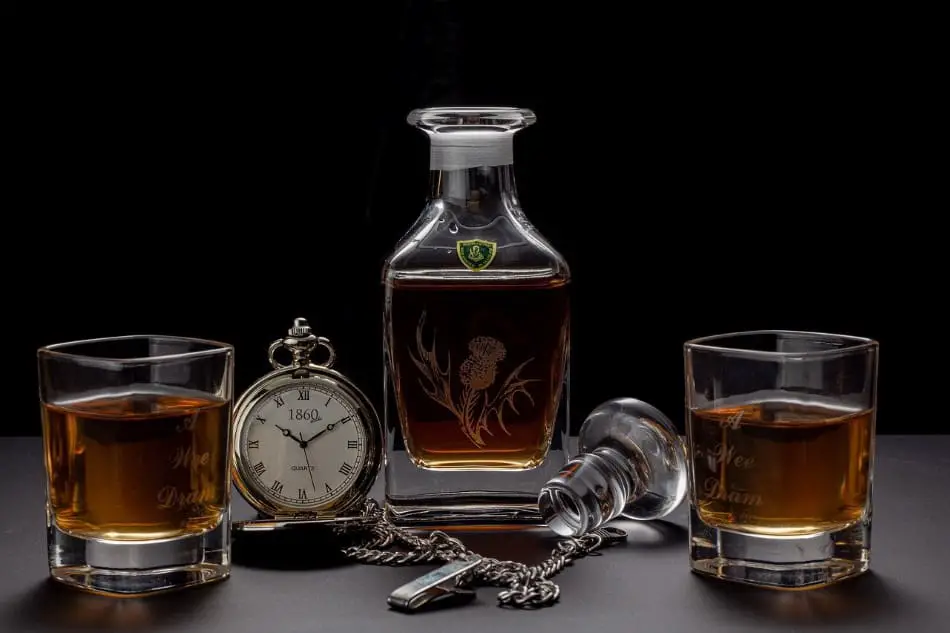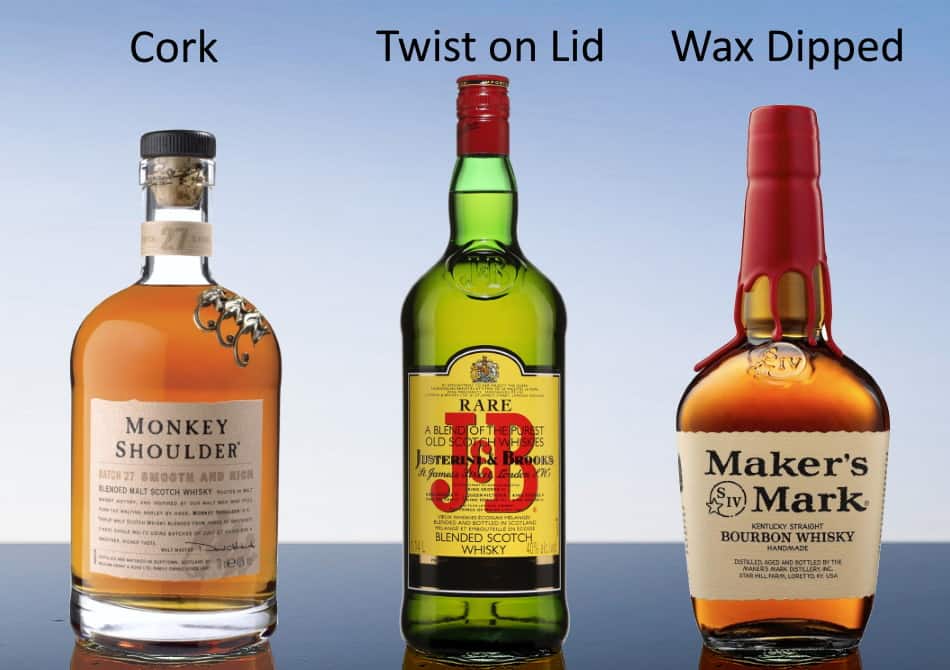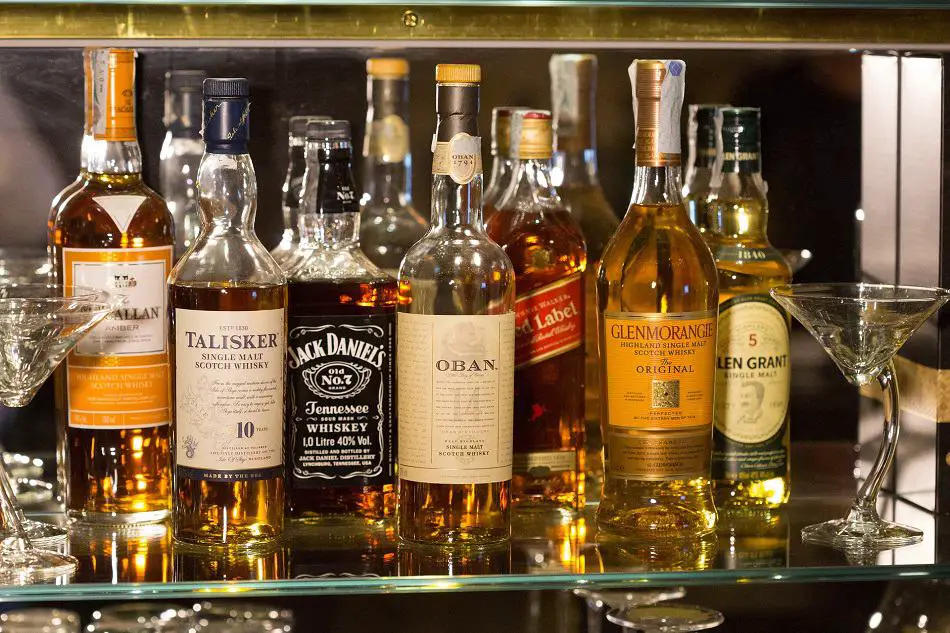Most people don’t want their whiskey to change. After all, it’s spent years or even decades maturing and acquiring specific flavors, and you’ve probably paid quite a lot of money for it too, so you’re going to want your whiskey to remain exactly the same as it was when you first bought it.
But whiskey does change and in different ways under different circumstances:
Whiskey changes in a closed bottle because it evaporates, although this will only be a problem after a few years. Whiskey changes in an opened bottle because it becomes oxidized after six months to two years. Whiskey also changes in a bottle that was stored in the wrong conditions.
In the rest of this article, we’ll look at the different ways in which whiskey changes in more detail, so that you can easily see what can be done to slow the process down. We’ll also look at some positive changes that can occur to whiskey when it’s in the glass and how to ensure they improve your whiskey and not ruin it.

How Whiskey Changes in An Unopened Bottle: Evaporation
Whiskey in an unopened, sealed bottle doesn’t change very much.
This is for two reasons. First, because unlike wine which gets its flavor from the grape it’s made from so it can continue to age even in a sealed bottle, whiskey gets its flavor from the wood of the barrel it’s matured in, so it obviously won’t change once it’s out of the barrel and in the bottle.
The second reason why whiskey in an unopened bottle doesn’t change very much is because of its high alcohol content – anywhere between 40% – 68% ABV, which helps preserve the whiskey in the bottle by freezing all its esters, congeners and volatile alcohols and placing them in suspended animation.
The change that can occur even in unopened and sealed bottles of whiskey is evaporation. That’s because even though the bottle is unopened the seal is not 100% airtight, so there’s still some room for the whiskey to escape.
Now the amount of whiskey that will evaporate from the not-quite-100%-airtight-seal is minimal, so you can store your whiskey for a while, even a few years, without having to worry about it. However, if you’re planning to store your whiskey for the long term – meaning decades, minimal evaporation over such a long period can be a problem.
It will depend on the type of seal your bottle has because some are more airtight than others. The types of seals whiskey bottles have in order of airtight-ness (lowest to highest) are:
- Cork
- Cork in a newer bottle (that are supposed to be better)
- Twist on lid
- Wax dipped

Modern wax dipped bottles are the most airtight with evaporation being almost nothing so even if you store your whiskey for decades, you probably won’t have a problem. However, if your bottle is sealed with a cork evaporation will become noticeable after ten years, and after 30 – 40 years evaporation will have decreased the filling level drastically. The change will be less in bottles sealed with a twist on lid.
Fortunately, you can prevent too much evaporation by making your bottle more or 100% airtight. One way to do this by attaching an additional seal. This can be an additional cap on top of the cork or by dipping the bottle in wax yourself. However, these methods can damage the bottle and the underlying seal causing its value to decrease – which defeats the point of storing it long term in the first place.
A better solution is to use parafilm. This is a film made from a blend of waxes and polyolefins that’s semi-transparent and flexible. It’s malleable, non-toxic, tasteless, odorless, and self-sealing. You can wrap it around the lid making it airtight and it won’t harm the underlying seal. The only downside is that after some time it becomes brittle and less effective, so it needs replacing every five to seven years. You can buy parafilm from Amazon.com here .
.
How Whiskey Changes in An Opened Bottle: Oxidation
Whiskey changes much more in an opened bottle because air can now get to it and cause oxidation. Oxidation is when oxygen binds to one chemical compound and turns it into another, and when oxygen gets into your whiskey and turns one chemical compound into another the result will be a change in its flavor.
This change in flavor doesn’t necessarily mean for the worse. It could be for the better, but you won’t know which way your whiskey will change and whether you want to prevent it until after it occurs.
Additionally, not only does whiskey change because the bottle is opened, it also changes because you’re drinking it. That sounds weird but let me explain. The more whiskey you drink the more air there will be inside the bottle – called the headspace. This makes oxidation occur faster and the remaining whiskey change sooner.
Fortunately, although oxidation starts as soon as you open the bottle, your whiskey won’t change for a while. Opened whiskey will start to change after six months to two years depending on the headspace. With an inch or two of headspace there won’t be much change in your whiskey for at least a year but if three quarters of the bottle is air, the whiskey will change in about a month.
That’s why it’s best to finish a bottle of whiskey within a few months of opening it, so you can drink it before it changes.

To ensure that oxidation doesn’t occur any faster you can do the following:
- Make sure your bottle is sealed tightly.
- If the original cork doesn’t seal your bottle well, buy a poly seal cap.
- If your bottle has a twist on lid, you should re-tighten it regularly because they often become loose on their own.
- You can transfer your whiskey into a hermetically sealed glass container.
- When the volume of whiskey decreases significantly you should transfer it into a smaller bottle to reduce the amount of headspace. This can be done more than once but there will come a time when the amount of whiskey will be so low that the best thing you can do will be to finish it as soon as possible.
How Whiskey Changes in A Bottle Stored Incorrectly
Storing a bottle of whiskey in the wrong place and in the wrong way will also cause it to change. The following are the wrong ways to store a bottle of whiskey and the changes they cause:
In Direct Light or Direct Sunlight
If you store a bottle of whiskey in direct sunlight it becomes discolored over time as the ultraviolet rays of the sun bleach out the color pigments of the whiskey.
Direct light and (worse) direct sunlight will change the flavor of whiskey as it creates chemical reactions in its volatile compounds causing them to break down. The flavor of whiskey stored in direct light or sunlight will degrade in one or two months causing it to taste much harsher, possibly even of rubber, paint thinner or rotten fruit.
In the Heat
When whiskey becomes hot it expands and comes into increasing contact with the cork. This will cause the cork to decay and disintegrate because 40% ABV or more will do that to wood. A damaged cork means a looser seal and more oxygen seeping in and changing the flavor of your whiskey.
In Fluctuating Temperatures
The same is true if you store whiskey in a place where there are a lot of temperature fluctuations. With every fluctuation, more oxygen can flow into the bottle and change the flavor of your whiskey.
Lying Down
Storing bottles of whiskey lying down puts the 40% ABV alcohol in constant contact with the cork and you get the same result as when storing bottles of whiskey in the heat. The alcohol will damage the cork and make the seal looser so more oxygen will get into the bottle and change the flavor of your whiskey.
To stop your whiskey changing because of being stored in the wrong conditions, make sure that your bottles are stored in the following way:
- Away from direct light and direct sunlight.
- In a cool and stable temperature – 15°-20°c or 59°-68°F will do.
- Standing up (although you need to turn your bottles every so often or the cork will become damaged and loose from being dried out).
For more information on how to store whiskey properly, see this more detailed article I wrote about it here.
How Whiskey Changes in The Glass – For the Better
Whiskey can also change when it’s just sitting in the glass. For the better.
This is because alcohol evaporates at a lower temperature than water, so when whiskey is just sitting in the glass for a period of time more alcohol will evaporate than water which reduces the ABV of the whiskey. This causes the whiskey to change because with less alcohol more of its flavors will open up.
Now obviously this whiskey change is for the better. Which is why before drinking whiskey some people do several things to increase the amount of air (which is now changing your whiskey for the better) that gets to whiskey as it causes more of the alcohol to evaporate:
- Use a nosing glass – it’s wide bowl has room for air to get to the whiskey.
- Swirling – this increases the amount of air to more parts of the whiskey.
- Let the whiskey sit for a few minutes – as well as allowing air to get to the whiskey this gives it time to cause more of the alcohol to evaporate.
Some whiskey drinkers add water or ice to their glass of whiskey for the same reason. Both dilute the whiskey, which reduces its level of alcohol and opens up more of its flavors. Each drop of water or piece of melting ice can change the flavors of your whiskey.
However, while water and ice can change your whiskey for the better too much of them will change your whiskey for the worse.
Too much water or ice can lead to your whiskey becoming diluted too much and ending up with no flavor at all. Too much ice can make your whiskey too cold which will mute its aromas and flavors. And if your whiskey is non chill filtered, too much alcohol dilution or cold can make it cloudy as the natural fatty acids, esters and proteins in whiskey un-dissolve in those conditions.
To ensure that water and ice change your whiskey for the better you need to control the amount you add to your whiskey, so it doesn’t become too diluted. And if the ice causes your whiskey to become cloudy or the aromas and flavors to become muted, simply let your whiskey heat up to room temperature as that will reverse both things. Any cloudiness will disappear, and the aromas and flavors will return.
